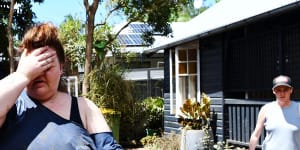“I don’t know if I want to see it,” she says,turning her body away from the phone in her hand,almost looking for somewhere to hide. She braces herself,turns back and answers.

Kymee Strow lost her business in Lismore where clean up efforts have begun.Elise Derwin
As record floodwaters recede in Lismore,Ms Strow is one of hundreds of residents surveying the devastation left in its wake.,with a mammoth clean-up effort now underway to recover what is left after business and homes were inundated.
Holding up the phone screen,Ms Strow’s hand starts shaking violently as Ms Jones shows her what’s left of their café in the CBD,just a few hundred metres away and only accessible by boat.
“Someone else has to hold it,I can’t hold it,” she says,and a friend takes the phone.
I’ve been talking to Ms Strow for almost half an hour. She’s shown me childhood photographs and woven rugs and artworks left out to dry. She’s shown me the ruined interior of her beautiful old weatherboard home,bought only three months ago,and her garden,covered in mud,which she’d only just finished landscaping. She’s kept it together,until now.
On the phone,I can see ceiling panels hanging from the roof,and what’s left of a trendy-looking café sitting in a few feet of water. Everything that was stored in the roof seems to have fallen into the water.
“Oh my God,the ceiling’s falling in. It’s not safe. You’ve got to get out,” she tells Ms Jones,the panic rising. “Just get out,just get out,” she warns,sobbing at the same time.
Up and down the street,Ms Strow’s neighbours are hauling out ruined belongings from their homes and piling them up on the kerb:chests of drawers,cots,mattresses,boxes of Christmas decorations. Dirty,sodden rugs hang from verandah railings.
Heartbroken residents are making their way back to what's left of their homes and are slowly starting the recovery effort amid the flood crisis in Lismore in NSW.
Those who aren’t lifting out ruined belongings have a hose in hand and are trying to clean all-consuming mud while it’s still wet,before it dries and turns to concrete.
They have been here since first light,when they found out the water that suddenly invaded their street in the dead of the night just over 48 hours earlier had beat a cruel retreat,revealing its destruction as it left.
The return is not an easy one. There is the sheer enormity of the damage and the task that lies ahead to clean it all up. Coming home has also brought back the trauma of what happened on that night,and they recount it in vivid detail. The rushing of the water,the sudden urgency to leave,floodwater splashing up on to car windows by the time they got out.
A few doors up from Ms Strow,I find Lee Hourigan trying to clean the mud out of her sprawling old house,which she rents with two others. It’s up for sale – listed for $1.5 million.

Lee Hourigan in her home on Dawson Street,Lismore.Elise Derwin
She’s a nurse and normally drives around the countryside,caring for people in remote and regional areas of Queensland,but she’s spent the past year recovering from a quadruple bypass and moved to Lismore to be closer to her older sister,who lives around the corner and is out the front at the moment,hosing off the frame of a day bed.
“Look at this,” Ms Hourigan says,running a finger over the edge of her bath. “It’s not just dirt,it’s oily. When I cleaned the toilet,I had to clean it five times.” There’s still mud in the bowl.
Ms Hourigan is bright as she shows me the house,and recounts her escape. She says she received no warning from the State Emergency Service about what was coming and when she rang for help,she only received a loop message.
“At 5am,I woke up to things crashing. I sat up and the water was lapping my bed. All my electrics were underwater,and I was worried[the water] would be electric … then I thought ‘f---,I’m going to have to risk it’. Sorry,Catholic girl swearing.”
Ms Hourigan says in the five minutes it took her to grab some belongings the water rose to her chest and she had to swim out of the house. “The water was swirling,there was debris everywhere. After I got to the back door,the fridge crashed behind me and would have blocked my way. I can’t tell you,the current was unbelievable.”

She crawled up and began hanging on to the eaves of her verandah and started yelling out for help. A young man in a kayak rescued her.
“Girls,the ones in their 20s and 30s,they’re the ones you want,” she jokes. “They’ve still got muscles to do things.”
But then she breaks down. “Those boys are the only thing that saved us,” she says. “They saved 100 people.”
When I first met Ms Strow,she was sorting through photographs on a table in her driveway,prying them apart and lying them out to dry. She pointed out a photograph of herself with a white-haired,smiling older lady - her grandmother,who died a month ago.
“I just found a card she sent me after the last flood,saying “you’ll overcome this. You’re so strong.”
The card was lying open,resting on top of the photographs. Her grandmother’s hand – blue pen on fresh white paper – stood out among the muddy remnants of Ms Strow’s life.
I mentioned people were saying this would be the end of Lismore,but she brushed it off.
“When you’re in trauma,in the moment,you say things that aren’t necessarily what you want … the people of Lismore don’t quit. It’s really f---ing shit. But you just clean up. You just keep going.”
The Morning Edition newsletter is our guide to the day’s most important and interesting stories,analysis and insights..